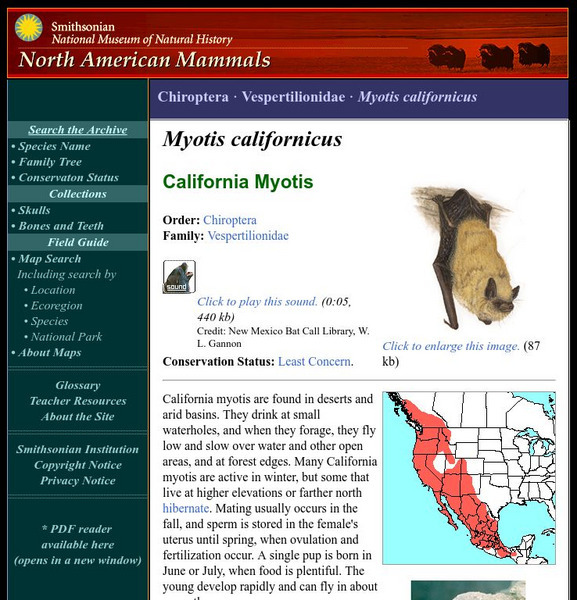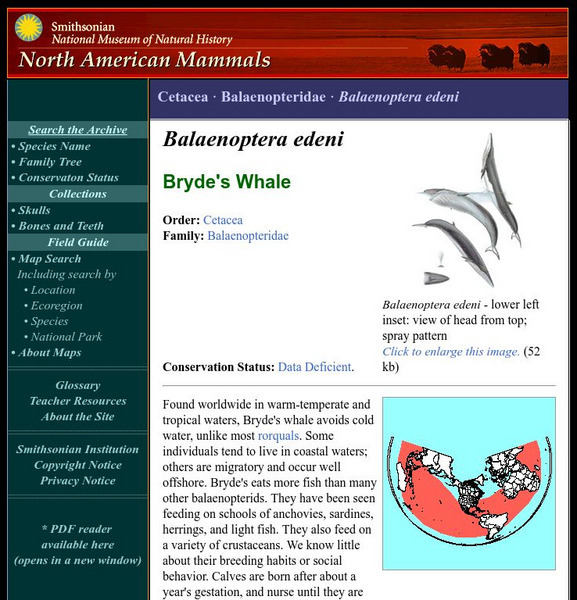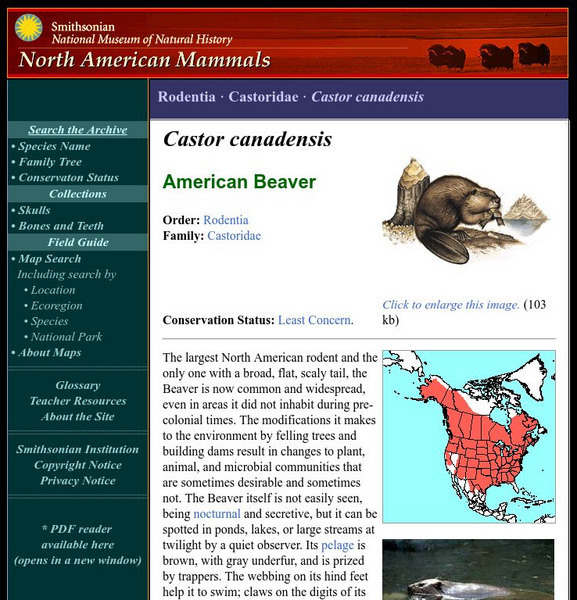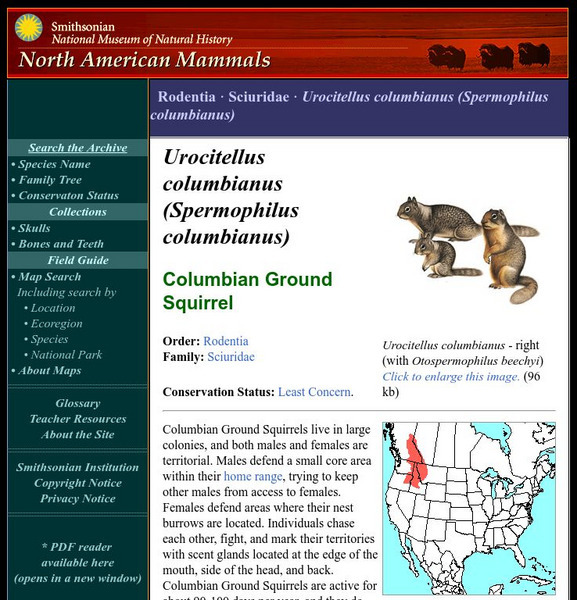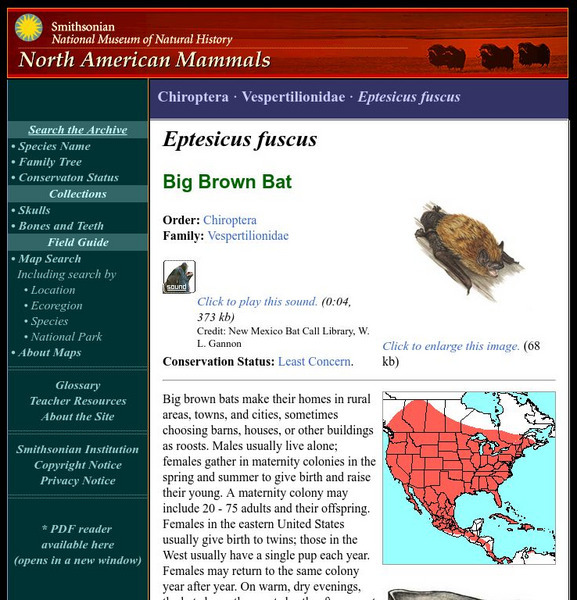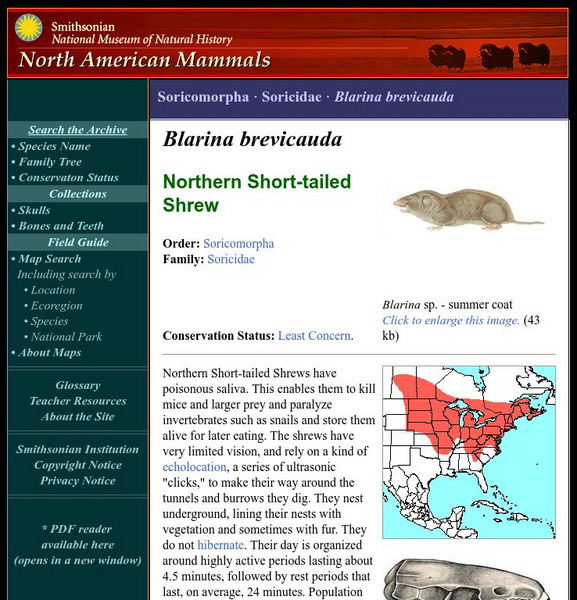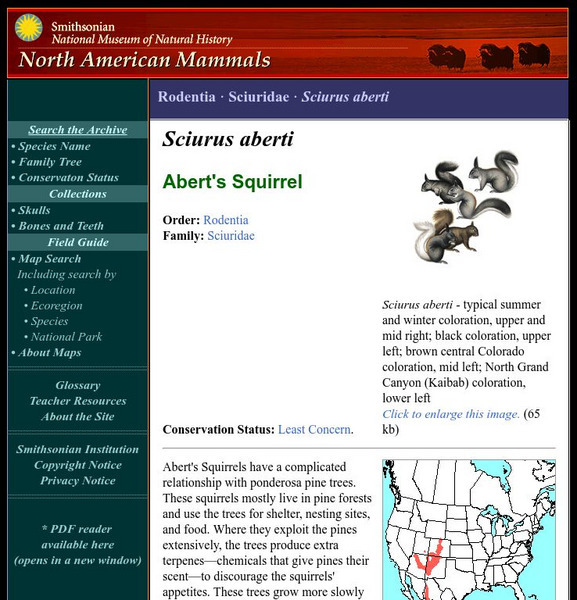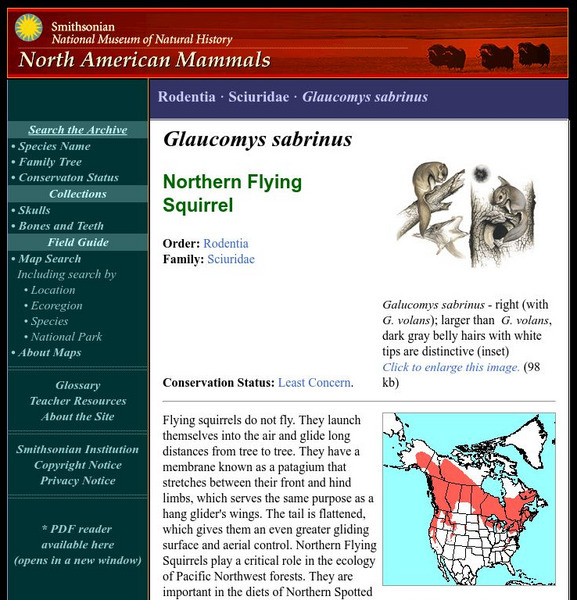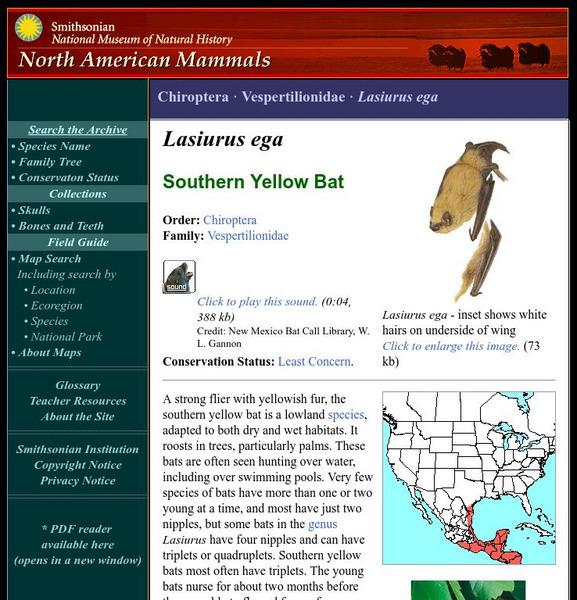Smithsonian Institution
National Museum of Natural History: American Mammals: California Myotis
California myotis are found in deserts and arid basins. They drink at small waterholes, and when they forage, they fly low and slow over water and other open areas, and at forest edges. Learn more about the Myotis californicus, more...
Smithsonian Institution
National Museum of Natural History: American Mammals: Bryde's Whale
Found worldwide in warm-temperate and tropical waters, Bryde's whale avoids cold water, unlike most rorquals. Some individuals tend to live in coastal waters; others are migratory and occur well offshore. Learn more about the...
Smithsonian Institution
National Museum of Natural History: American Mammals: American Beaver
The largest North American rodent and the only one with a broad, flat, scaly tail, the Beaver is now common and widespread, even in areas it did not inhabit during pre-colonial times. The modifications it makes to the environment by...
Smithsonian Institution
National Museum of Natural History: American Mammals: Columbian Ground Squirrel
Columbian Ground Squirrels live in large colonies, and both males and females are territorial. Males defend a small core area within their home range, trying to keep other males from access to females. Learn more about the Spermophilus...
Smithsonian Institution
National Museum of Natural History: American Mammals: Arctic Ground Squirrel
Arctic Ground Squirrels must cope with a harsh environment that offers long, cold winters, strong winds, a short growing season, permafrost, poor drainage, and limited cover. The squirrels are, by necessity, dormant for seven months each...
Smithsonian Institution
National Museum of Natural History: American Mammals: Cliff Chipmunk
Cliff chipmunk fossils about 2,300 and 8,000 years old have been found in caves in Utah and Nevada. The chipmunks still live in those states, in habitats where sagebrush, fourwing saltbush, chokecherry, wild rose, and cliffrose grow....
Smithsonian Institution
National Museum of Natural History: American Mammals: Colorado Chipmunk
Colorado chipmunks are solitary and territorial, and adults avoid each other except during the breeding season. Males emerge from their burrows in the spring ready to mate. Learn more about the Tamias quadrivittatus, more commonly known...
Smithsonian Institution
National Museum of Natural History: American Mammals: Bottlenose Dolphin
Bottlenose dolphins have widely spaced eyes, relatively long flippers, a rounded forehead (called a melon), a relatively short, broad snout, and a mouth that seems permanently twisted into a grin. Inside the mouth are as many as 100...
Smithsonian Institution
National Museum of Natural History: American Mammals: Brown Bear, Grizzly Bear
Brown Bears are solitary, powerful predators who can be aggressive to one another. There is a social hierarchy: adult males are dominant, and females with cubs are dominant over juvenile males and females without cubs. Learn more about...
Smithsonian Institution
National Museum of Natural History: American Mammals: California Sea Lion
California sea lions are the best-known eared seals. All seals can hear, but earless seals (in the family Phocidae) have internal ears. Learn more about the Zalophus californianus, more commonly known as a California Sea Lion, in this...
Smithsonian Institution
National Museum of Natural History: American Mammals: Big Brown Bat
Big brown bats make their homes in rural areas, towns, and cities, sometimes choosing barns, houses, or other buildings as roosts. Males usually live alone; females gather in maternity colonies in the spring and summer to give birth and...
Smithsonian Institution
National Museum of Natural History: American Mammals: Bearded Seal
Bearded seals have relatively small heads and prominent whiskers. Males and females are similar in size and appearance. Learn more about the Erignathus barbatus, more commonly known as a Bearded Seal, in this easy-to-read species...
Smithsonian Institution
National Museum of Natural History: American Mammals: Northern Right Whale Dolphin
With no dorsal fin, a slender body shape that tapers steadily toward the tail, and small flippers and flukes, the northern right whale dolphin appears to be built for speed. It has been clocked at 34 km per hour and can dive as deep as...
Smithsonian Institution
National Museum of Natural History: American Mammals: Alaska Marmot
The Alaska Marmot lives in the Brooks Range, in northern Alaska, squeezing between big, bulky rocks on slopes to dig its dens. Denning on rocky ledges or under boulders offers them some protection from grizzly bears, which would...
Smithsonian Institution
National Museum of Natural History: American Mammals: Northern Short Tailed Shrew
Northern Short-tailed Shrews have poisonous saliva. This enables them to kill mice and larger prey and paralyze invertebrates such as snails and store them alive for later eating. Learn more about the Blarina brevicauda, more commonly...
Smithsonian Institution
National Museum of Natural History: American Mammals: Southern Short Tailed Shrew
The Southern Short-tailed Shrew is a highly active, primarily nocturnal predator. It is most common in moist, well-drained hardwood forests or pine stands, especially where deep organic litter provides easy burrowing for shelter and...
Smithsonian Institution
National Museum of Natural History: American Mammals: Abert's Squirrel
Abert's Squirrels have a complicated relationship with ponderosa pine trees. These squirrels mostly live in pine forests and use the trees for shelter, nesting sites, and food. Learn more about the Sciurus aberti, more commonly known as...
Smithsonian Institution
National Museum of Natural History: American Mammals: Richardson's Collared Lemming
Richardson's Collared Lemmings are active 24 hours a day. They are found in tundra, and avoid marshy habitats and forested areas. Learn more about the Dicrostonyx richardsoni, more commonly known as a Richardson's Collared Lemming, in...
Smithsonian Institution
National Museum of Natural History: American Mammals: Agile Kangaroo Rat
Agile Kangaroo Rats are excellent swimmers. They can run on all four feet as well as hop on their large hind feet, and if they are fleeing a predator, can make sharp turns. Learn more about the Dipodomys agilis, more commonly known as an...
Smithsonian Institution
National Museum of Natural History: American Mammals: Northern Flying Squirrel
Flying squirrels do not fly. They launch themselves into the air and glide long distances from tree to tree. Learn more about the Glaucomys sabrinus, more commonly known as a Northern Flying Squirrel, in this easy-to-read species...
Smithsonian Institution
National Museum of Natural History: American Mammals: Southern Yellow Bat
A strong flier with yellowish fur, the southern yellow bat is a lowland species, adapted to both dry and wet habitats. It roosts in trees, particularly palms. Learn more about the Lasiurus ega, more commonly known as a Southern Yellow...
Smithsonian Institution
National Museum of Natural History: American Mammals: Sagebrush Vole
Sagebrush Voles usually live in colonies in semiarid, partly brushy habitat. The dominant plants where they live are sagebrush or rabbitbrush mixed with bunchgrass. Learn more about the Lemmiscus curtatus, more commonly known as a...
Smithsonian Institution
National Museum of Natural History: American Mammals: Margay
Margays are small spotted cats that closely resemble ocelots, but are about half the size and lack the ocelot's two prominent black cheek stripes. Margays are forest-dwellers and good climbers and jumpers, so agile that captives have...
Smithsonian Institution
National Museum of Natural History: American Mammals: Vancouver Marmot
Vancouver Marmots live only on Vancouver Island, British Columbia. They are the only endangered mammal in Canada, with a population estimated at only 100-200 individuals. Learn more about the Marmota vancouverensis, more commonly known...
